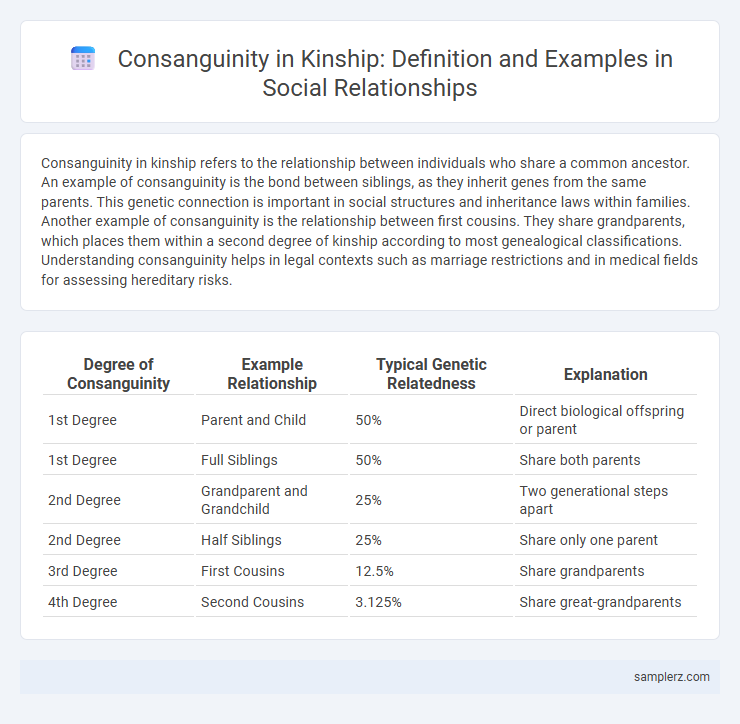Consanguinity in kinship refers to the relationship between individuals who share a common ancestor. An example of consanguinity is the bond between siblings, as they inherit genes from the same parents. This genetic connection is important in social structures and inheritance laws within families. Another example of consanguinity is the relationship between first cousins. They share grandparents, which places them within a second degree of kinship according to most genealogical classifications. Understanding consanguinity helps in legal contexts such as marriage restrictions and in medical fields for assessing hereditary risks.
Table of Comparison
| Degree of Consanguinity | Example Relationship | Typical Genetic Relatedness | Explanation |
|---|---|---|---|
| 1st Degree | Parent and Child | 50% | Direct biological offspring or parent |
| 1st Degree | Full Siblings | 50% | Share both parents |
| 2nd Degree | Grandparent and Grandchild | 25% | Two generational steps apart |
| 2nd Degree | Half Siblings | 25% | Share only one parent |
| 3rd Degree | First Cousins | 12.5% | Share grandparents |
| 4th Degree | Second Cousins | 3.125% | Share great-grandparents |
Understanding Consanguinity in Kinship Networks
Consanguinity in kinship networks refers to relationships established through shared blood lineage, such as parent-child, sibling, and cousin connections. These biological ties form the foundation for inheritance rights, family roles, and obligations within many societies. Understanding consanguinity is crucial for analyzing social structures, marriage restrictions, and genetic inheritance patterns.
Common Forms of Consanguineous Relationships
Common forms of consanguineous relationships include unions between first cousins, second cousins, and uncle-niece pairs. These relationships are prevalent in many societies due to cultural, social, and economic factors that encourage marriage within extended family circles. Consanguinity increases the probability of shared genetic traits and hereditary conditions, impacting demographic and health patterns in affected populations.
Real-World Instances of Consanguinity in Families
Real-world instances of consanguinity in families often occur in cultures where cousin marriages are prevalent, such as in parts of the Middle East, South Asia, and North Africa. These consanguineous unions increase the probability of inheriting recessive genetic disorders, with studies indicating higher rates of conditions like thalassemia and cystic fibrosis among offspring. Genetic counseling and public health initiatives are crucial in these regions to manage and reduce the risks associated with consanguinity in kinship networks.
Cultural Perspectives on Consanguineous Marriages
Consanguineous marriages, commonly found in Middle Eastern, South Asian, and North African cultures, often reinforce familial ties and preserve wealth within kinship networks. These unions, typically between first cousins, are culturally valorized for maintaining social cohesion and upholding traditional lineage structures. Genetic counselors increasingly emphasize the need for community-specific education to address potential health risks while respecting cultural values surrounding consanguinity.
Social Implications of Close-Kin Unions
Consanguinity in kinship, such as marriage between first cousins, often leads to intensified social cohesion within families but simultaneously raises concerns about increased genetic risks for offspring. These unions can reinforce traditional social structures and inheritance patterns, yet they may also contribute to stigmatization or discrimination in broader society. Public health initiatives and genetic counseling are critical in communities where close-kin marriages are prevalent to mitigate adverse social and biological outcomes.
Health Outcomes Associated with Consanguinity
Consanguinity, or marriage between blood relatives, significantly increases the risk of inheriting autosomal recessive genetic disorders, resulting in higher incidences of congenital anomalies and developmental delays in offspring. Studies indicate that populations with high rates of consanguineous unions exhibit increased prevalence of conditions such as beta-thalassemia, cystic fibrosis, and metabolic disorders. Health outcomes also include elevated neonatal mortality rates and greater susceptibility to multifactorial diseases due to reduced genetic diversity.
Historical Cases of Consanguinity in Royal Families
Historical cases of consanguinity in royal families often involved strategic marriages between close relatives to preserve lineage and consolidate power. Notable examples include the Habsburg dynasty, where repeated cousin marriages led to the infamous "Habsburg jaw" and various genetic disorders. Such consanguineous unions were common in Egyptian, European, and Asian monarchies, profoundly impacting their historical health and succession.
Community Attitudes Toward Consanguinity
Consanguinity, or marriage between close relatives, remains prevalent in various cultures, influencing community attitudes based on social, economic, and religious factors. In many Middle Eastern and South Asian societies, consanguineous marriages are often viewed positively due to perceived benefits like family cohesion and property retention. However, increasing awareness of genetic health risks has led some communities to gradually shift toward more skepticism and discouragement of such unions.
Legal and Ethical Issues Around Consanguineous Kin
Consanguinity in kinship often raises significant legal and ethical issues, particularly regarding inheritance rights and marriage restrictions stipulated by law to prevent genetic disorders. Many jurisdictions enforce strict regulations on consanguineous unions to protect public health while grappling with cultural sensitivities and personal freedoms. Ethical debates focus on balancing respect for cultural practices with the imperative to minimize potential genetic risks to offspring.
Strategies for Addressing Consanguinity-Related Challenges
Consanguinity in kinship, such as cousin marriages common in certain cultures, increases the risk of genetic disorders and congenital anomalies among offspring. Strategies for addressing consanguinity-related challenges include genetic counseling, community education programs, and implementation of premarital screening to inform couples about potential health risks. Public health policies promoting awareness and access to reproductive health services help mitigate the impact of consanguinity on affected populations.

example of consanguinity in kin Infographic
 samplerz.com
samplerz.com